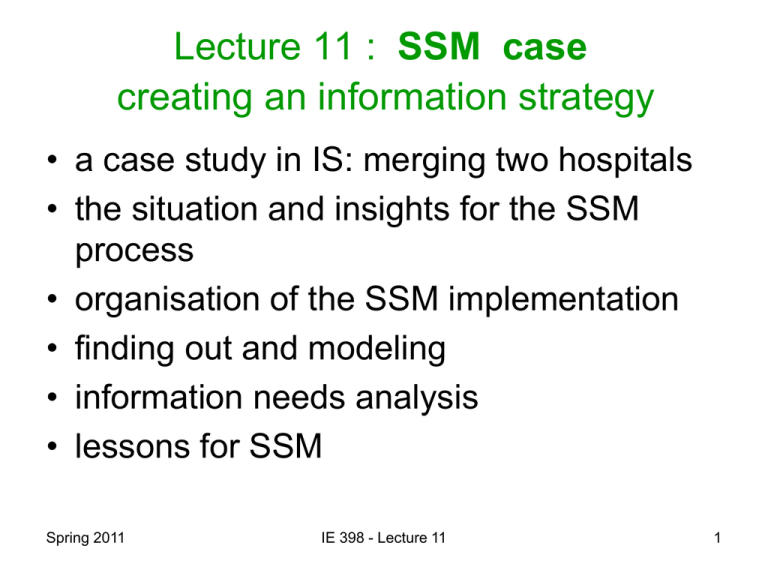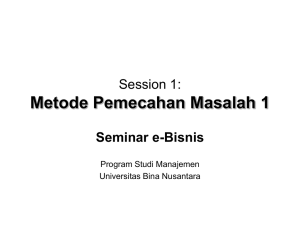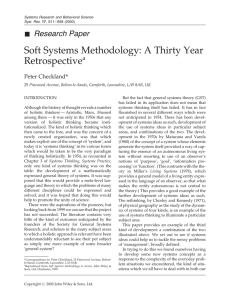SSM case creating an information strategy
advertisement

Lecture 11 : SSM case creating an information strategy • a case study in IS: merging two hospitals • the situation and insights for the SSM process • organisation of the SSM implementation • finding out and modeling • information needs analysis • lessons for SSM Spring 2011 IE 398 - Lecture 11 1 merging a large acute hospital and a small hospital in NHS • NHS provides health-care nationally, “from cradle to grave” – hence it is a very large organisation, – with wide spectrum and heavily involved in expertise and a variety of services • difficulties in funding have increased over time • attempts are made in the 90’s to improve efficiency and effectiveness by introducing the internal market concept: – district authorities are to act as purchasers of health services and buy from providers who are autonomous Trusts – according to nonbinding contracts for an agreed sum of money Spring 2011 IE 398 - Lecture 11 2 • Trusts had to think more seriously about their information systems – as quality, timeliness and costs matter • an acute hospital, The Royal Victoria Infirmary and the smaller Hexham General Hospital are to merge as a trust at two distant sites • an acute hospital is a large teaching organisation that delivers a range of services to patients who – are referred to it by GP’s or – enter as result of accidents and emergencies • the merger warrants new and effective IT and IS systems • these needs were initially thought to simply require new computer purchases without much consideration given to analyzing and scoping the use Spring 2011 IE 398 - Lecture 11 3 Spring 2011 IE 398 - Lecture 11 4 the situation and insights for the SSM process • the new Information Officer saw the need for a new IS strategy and assembled a group of facilitators • SSM was seen as suitable by the IO to this end • purposeful activity models had to play the key role in developing such a strategy • research would have to be carried out by about 40 groups of hospital professionals, not by IT or IS specialists such as – doctors – nurses – accountants etc. Spring 2011 IE 398 - Lecture 11 5 organisation of the SSM implementation • each group would be assigned a function that takes place at two sites and examine the core purpose, activities and information needs such as: – – – – – surgery medicine nursing theathres business.. • team members would keep on carrying their routine tasks as usual with no exception • a strategy was to be developed within six months, so the information strategy would be based on the current pattern of activities Spring 2011 IE 398 - Lecture 11 6 • facilitators were: the Information Officer, a senior management consultant, and P.Checkland • a joint workshop every month of team representatives with the three facilitators would meet to discuss proress and problems • Checkland’s ideas at the outset were: – construct activity models only for major hospital activities – discuss information needs based upon these models – compare present information support with the needs elicited in the above – re-formulate strategy • needed only “primary task” models, as thinking in-depth would not find much chance of application within reasonable time Spring 2011 IE 398 - Lecture 11 7 Spring 2011 IE 398 - Lecture 11 8 • project was to be integrated into the dayto-day activity of the two hospitals • the project was launched by the CEO of the acute hospital in a meeting of about 100 people • strategy was emphasized to emerge from the group and not from the management • CEO’s involvement demonstrated that the study was taken seriously by the Trust • three facilitators explained the work to do Spring 2011 IE 398 - Lecture 11 9 • Checkland prepared, at several levels, generic models relevant to acute hospital operation • this was a choice made specific to this situation • IS would be shaped to serve taking the current hospital organisation as given • analysis two and three were skipped, since the study addressed an explicit question in this particular situation • generic activity models would be enriched by considering and engaging in debates over the accounts of CATWOE and 3E’s Spring 2011 IE 398 - Lecture 11 10 finding out and modelling A generic model that would be relevant to any acute hospital, was initially constructed. Its Root Definition was: A system, operating under a range of external influences, which, in the light of a strategy based on its capabilities and costs, delivers services defined in 'contracts' with purchasers within the context of NHS norms and policies, that service delivery itself contributing to the ongoing development of its strategy for service provision. C those receiving hospital services, purchasers A hospital professionals T need for acute services need for acute services met W acute services can best be provided by an organization dedicated to developing and delivering such services O hospital management board; NHS executive E NHS structures and norms, the purchaser-provider split E1, efficacy demonstrable delivery of a portfolio of services of suitable quality E2, efficiency minimum use of resources (expressible in money and time) E 3, effectiveness satisfaction of patients treated, purchasers, the NHS executive, contributions to hospital reputation (i.e. contributions to long-term viability] Spring 2011 IE 398 - Lecture 11 11 Spring 2011 IE 398 - Lecture 11 12 • this is a low resolution activity model for a generic acute hospital • in this model, activities 2-5 are expanded collectively under the external influences in activity 1 • there is an inner feedback loop from 5 to 2 which monitors against plans and “contracts” versus monitoring the overall activity system from 3E’s perspective • a higher resolution model of each activity is essentially needed to assess information needs Spring 2011 IE 398 - Lecture 11 13 Spring 2011 IE 398 - Lecture 11 14 • primary task form is preserved in the higher resolution model • CATWOE for a generic service S in the detailed diagram C Patients, ancillary support services A Providers of clinical service T Need for service S need for service S met W The capability and organization for professional provision of service S is available and appropriate O Senior hospital managers, including doctors E NHS norms, hospital organization structure; contract requirements E1, efficacy demonstrable delivery of a service of suitable quality E2, efficiency minimum use of resources (expressible in money and time) E3, effectiveness Spring 2011 satisfaction of the serviced people, meet negotiated contractual clauses for particular service IE 398 - Lecture 11 15 • more detailed modelling was taken further only by one more step for some of the activities • experience indicates that modelling beyond three levels of detail -starting from the overall organization at the topmost level- is often not useful • the rule is to stop at the level where most problematical features lie Spring 2011 IE 398 - Lecture 11 16 information needs analysis • generic models helped to underline the point that SSM models were useful to structure discussions and were not descriptions of real-world examples • rather than the usual inquiry for the activities and their linkages, they helped to answer questions like, – what information should be available to someone doing this activity? – what is available at present? – what information is generated by doing this activity? – to whom should it go? • gaps and opportunities not revealed directly by models, emerged from discussion and debate Spring 2011 IE 398 - Lecture 11 17 Table 4.1 An illustration of the kind of chart used for information analysis Activities from the How the activity model is done --------------------------- -------------------- Measures of Information Information support performance --------------- needed -------------- provided by opportunities -------------------- ---------------------- Information gaps and 4.1.4 and 4.1.5 Receive request for Letter, phone call Speed with which Patient's details, Patient Automatic generation of service, and accept the request is clinical condition, administration letters to patient and patient handled and history referrer Contract situation Spring 2011 IE 398 - Lecture 11 system (PAS) Up-to-date contract situation 18 Table 4.1 An illustration of the kind of chart used for information analysis (cont.d) Activities from the How the activity Measures of model -------------------------4.1.6 is done -------------------- performance needed ------------------------- Diagnose problem Consider history Medical audit Information Information support Information gaps and provided by ---------------------- opportunities ---------------------- Case notes Case notes often missing Examine patient Results from Much duplication of Conduct investigations recording of patient's investigations details Delays in receiving test results Spring 2011 IE 398 - Lecture 11 19 Table 4.1 An illustration of the kind of chart used for information analysis (cont.d) Activities from the How the activity Measures of model -------------------------4.1.7 is done -------------------- performance needed ------------------------- Treat patient Conduct proce- Information Information support Information gaps and provided by ---------------------- opportunities ---------------------- Medical audit Availability of dures/operations Facilities, theatres, Prescribe drugs anesthetics, etc. Theatre booking Systems not available at system ward level Drug effects and interactions Spring 2011 IE 398 - Lecture 11 20 Table 4.1 An illustration of the kind of chart used for information analysis (cont.d) Activities from the How the activity Measures of Information Information support Information gaps and provided by ---------------------- opportunities ---------------------- model is done -------------------------- -------------------4.1.8 performance needed ------------------------- Discharge patient Speed with Post-treatment test which produced results of care Availability of discharge facilities Coding Automatic generation of discharge summaries and letters Support for Read coding Discharge summary Discharge letter Spring 2011 IE 398 - Lecture 11 PAS Links to ongoing providers 21 lessons for SSM • lack of knowledge was not a problem: “..grasping of SSM is much easier in a live situation than in a classroom.” • such a methodology which feels natural can help to counter the feeling among the members of a large complex organisation of no definite course to follow and no knowledge of direction • group working on nursing services appreciated CATWOE as they considered “hospital contract manager” in addition to the “patients” in C, among the victims or beneficiaries: – nurses provide service according to the contract – this came counter to nurses’ professionalism • the project was a good example of the LUMAS model Spring 2011 IE 398 - Lecture 11 22 Spring 2011 IE 398 - Lecture 11 23


